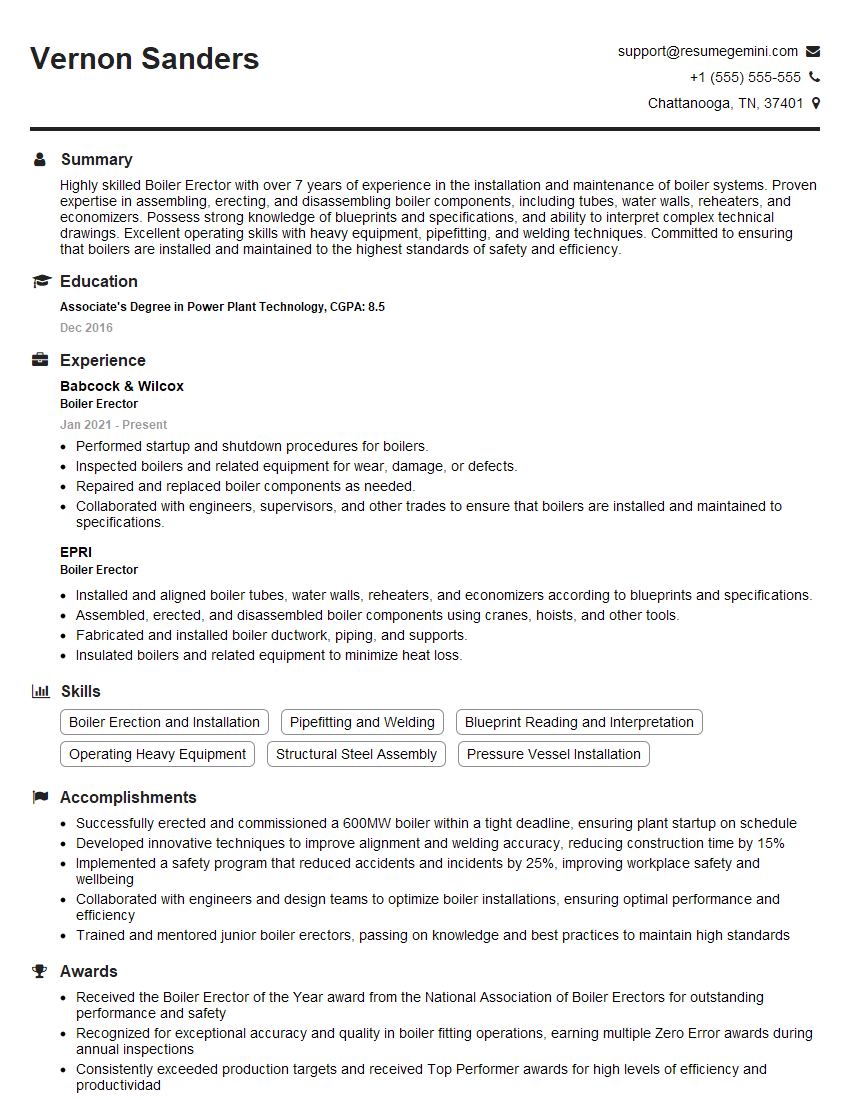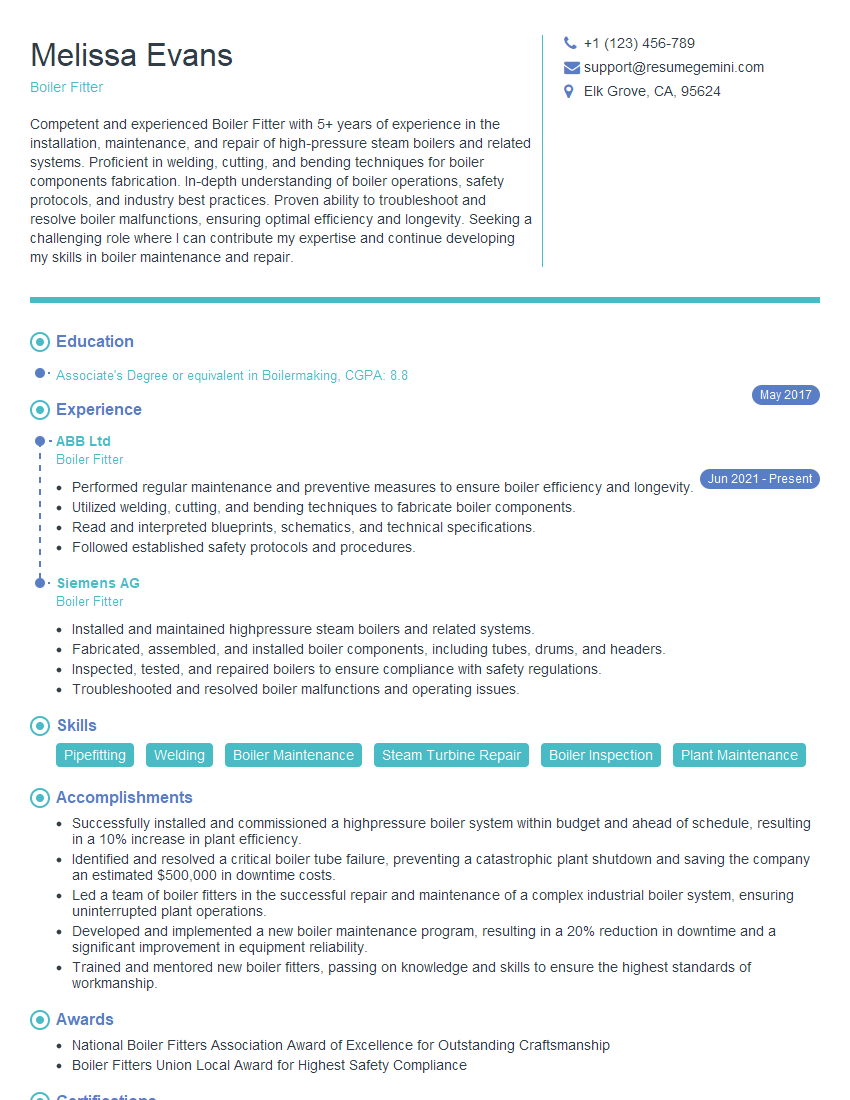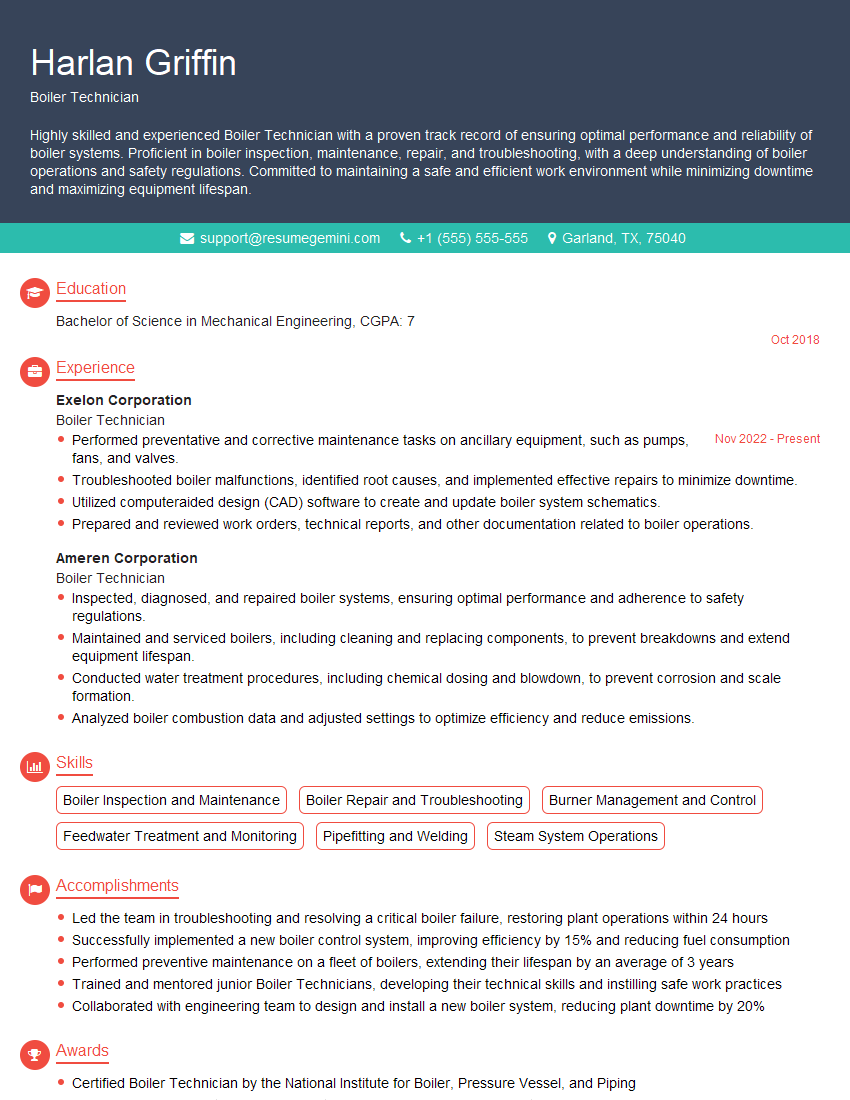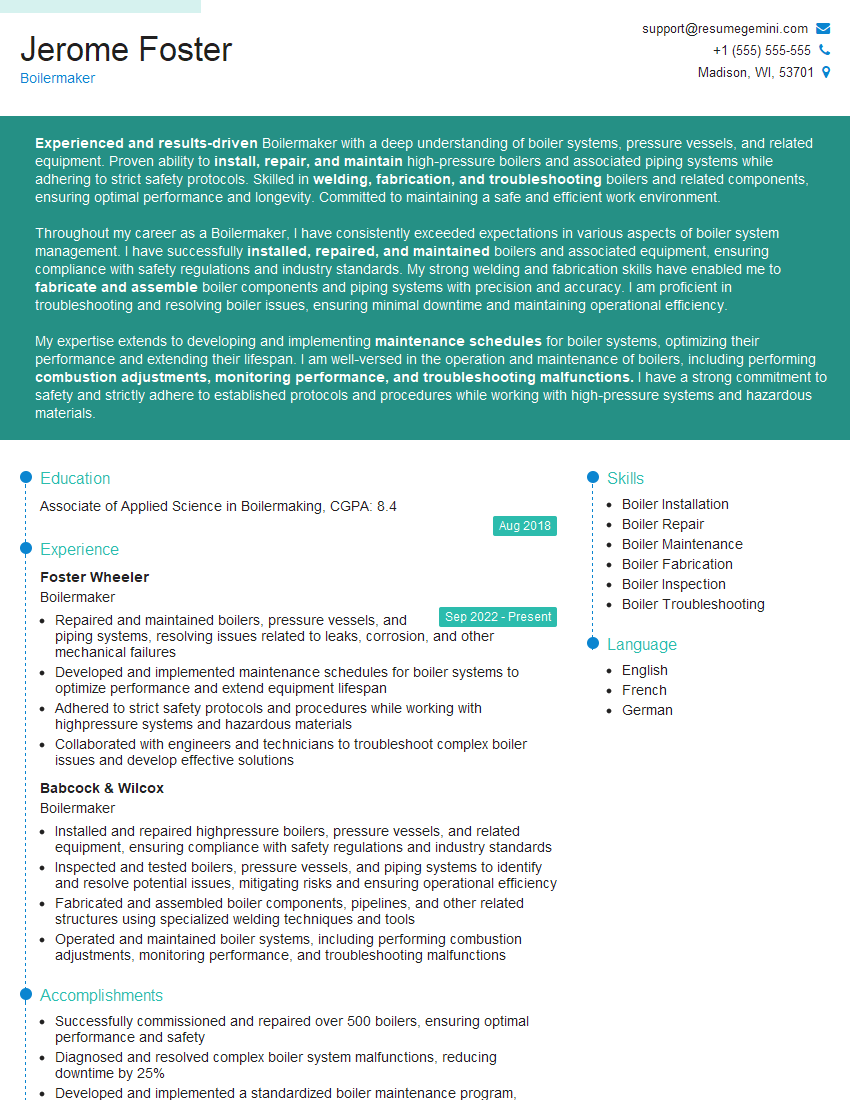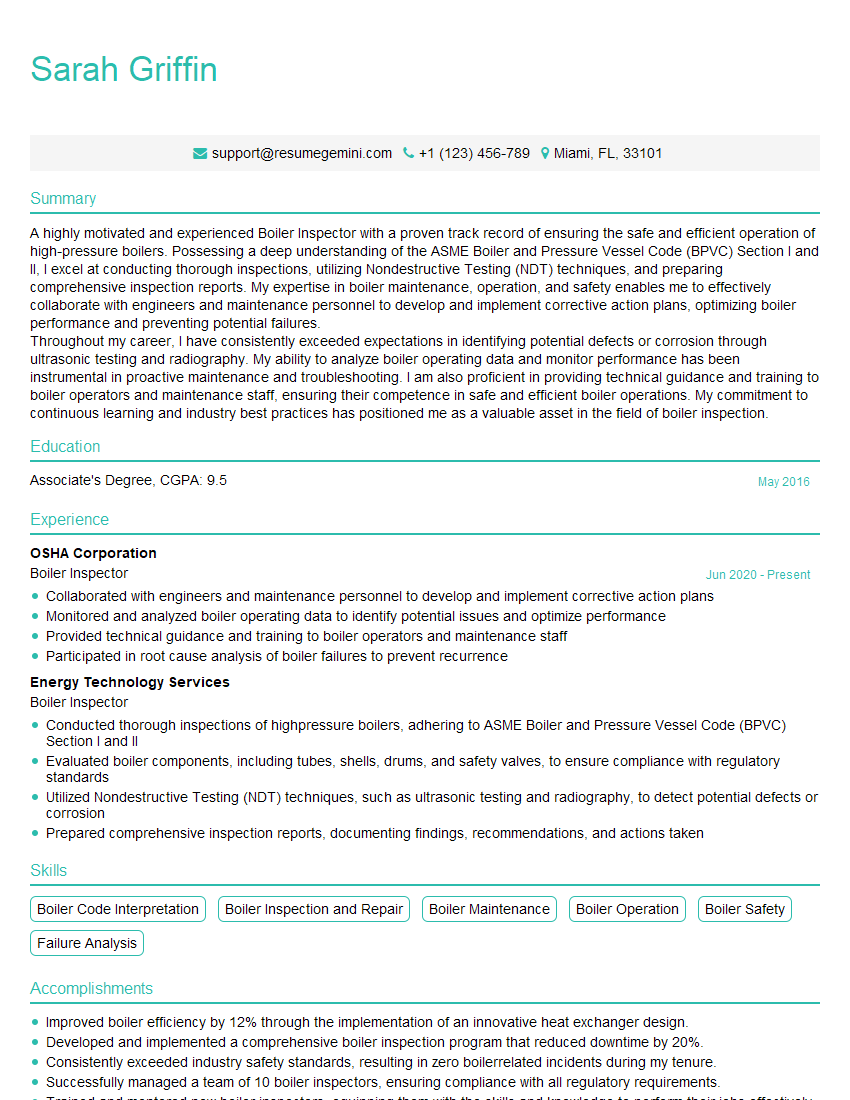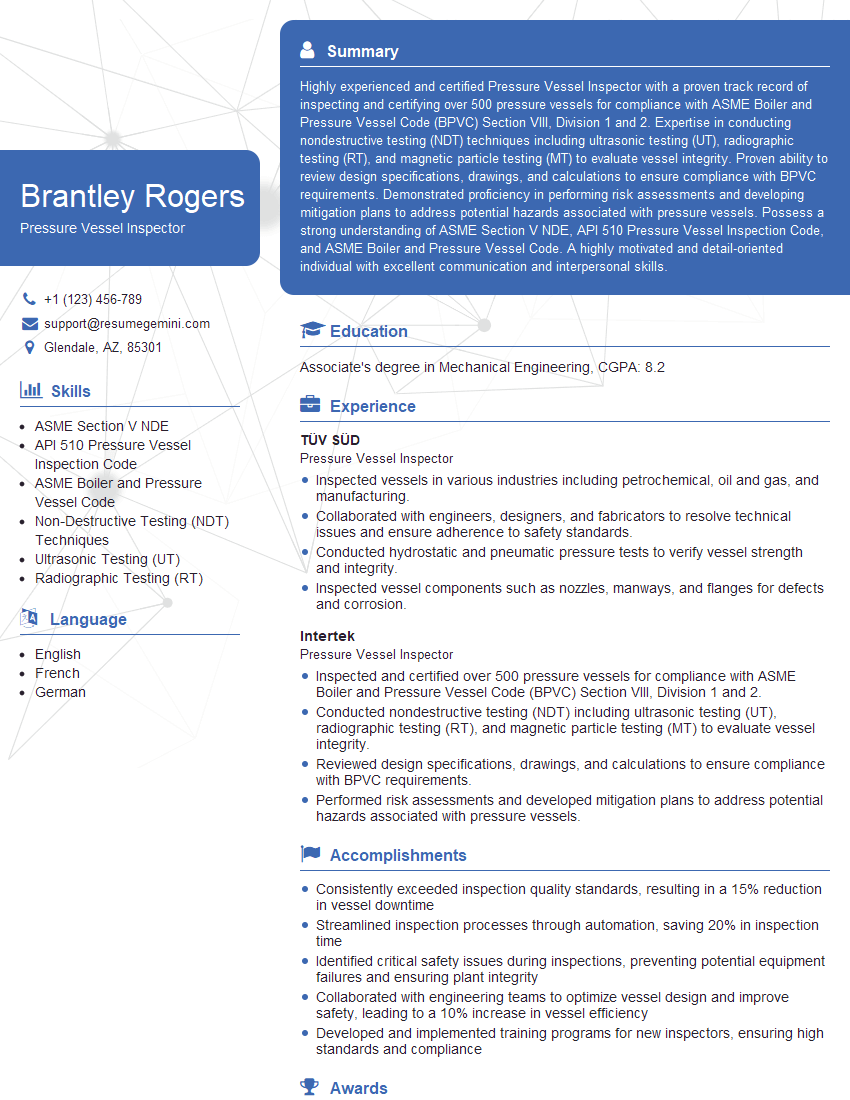Feeling uncertain about what to expect in your upcoming interview? We’ve got you covered! This blog highlights the most important Boiler Fabricating interview questions and provides actionable advice to help you stand out as the ideal candidate. Let’s pave the way for your success.
Questions Asked in Boiler Fabricating Interview
Q 1. Explain the different types of boiler designs and their applications.
Boiler designs vary significantly depending on their intended application and the type of fuel used. Here are some common types:
- Fire-Tube Boilers: Hot gases pass through tubes surrounded by water. They’re simpler and often less expensive, suitable for smaller-scale applications like heating buildings or providing hot water for industrial processes. An example is a horizontal return tubular (HRT) boiler.
- Water-Tube Boilers: Water circulates inside tubes surrounded by hot gases. These are generally more efficient and capable of handling higher pressures and larger steam demands, making them ideal for power generation and large-scale industrial applications. Examples include Babcock & Wilcox and Benson boilers.
- Firetube Boilers (Specific Types): These include vertical fire tube boilers, which are compact and suitable for limited space, and Scotch marine boilers, known for their robustness and use in marine applications.
- Water-Tube Boilers (Specific Types): Examples include D-type boilers, commonly found in power plants, and packaged water-tube boilers, which are pre-assembled units ready for installation.
The choice depends critically on factors like steam capacity, pressure requirements, space constraints, fuel type, and budget. For instance, a power plant would require a high-capacity water-tube boiler, while a small bakery might utilize a smaller fire-tube unit.
Q 2. Describe the process of boiler fabrication from design to completion.
Boiler fabrication is a meticulous process, starting with the design phase and culminating in rigorous testing. Here’s a breakdown:
- Design & Engineering: This involves detailed drawings, calculations to ensure structural integrity and compliance with codes, material selection based on operating conditions (pressure, temperature, etc.), and the creation of fabrication drawings.
- Material Procurement: High-quality steel plates, tubes, and other components are sourced according to specifications. Traceability is crucial to ensure material compliance.
- Cutting & Forming: Plates are cut to precise dimensions using plasma cutting, laser cutting, or other methods. Complex shapes are formed using press brakes, rolling machines, or other specialized equipment.
- Welding: This is a critical phase, employing various techniques (discussed in the next question) to join the components. Welders must be certified and follow strict procedures to guarantee weld quality.
- Assembly & Erection: Welded components are assembled into the boiler’s structure, often in a large assembly area. This might involve lifting heavy components with cranes.
- Non-Destructive Testing (NDT): Methods like radiography, ultrasonic testing, and liquid penetrant inspection detect flaws in welds and materials without damaging them.
- Surface Finishing: This can involve shot blasting to remove mill scale or painting for corrosion protection.
- Hydrostatic Testing: The boiler is filled with water and pressurized to verify its ability to withstand operating pressures, checking for leaks.
- Commissioning & Start-up: This involves checking all systems, including controls and safety devices, before the boiler is put into operation.
Think of it like building a complex puzzle, but with extremely high safety standards and precise measurements – a single error could have catastrophic consequences.
Q 3. What are the common welding techniques used in boiler fabrication?
Various welding techniques are employed in boiler fabrication, each with its strengths and weaknesses:
- Shielded Metal Arc Welding (SMAW): A versatile and relatively inexpensive process, suitable for various thicknesses but prone to some inconsistencies if not performed carefully. It’s often used for less critical welds.
- Gas Metal Arc Welding (GMAW): Also known as MIG welding, this offers high deposition rates and good quality, making it suitable for thicker materials and large-scale applications. It’s commonly used in boiler fabrication for its speed and efficiency.
- Gas Tungsten Arc Welding (GTAW): Or TIG welding, provides excellent control over the weld pool and high-quality welds, vital for critical components or thin sections. It’s slower but ensures precise and visually appealing welds.
- Submerged Arc Welding (SAW): This highly productive process is suited for long, continuous welds on thicker plates, increasing efficiency in large-scale boiler fabrication.
The selection depends on factors such as material thickness, weld joint design, access, and the required weld quality. Often, a combination of methods is used in a single boiler construction.
Q 4. How do you ensure code compliance during boiler fabrication?
Code compliance is paramount in boiler fabrication. We adhere strictly to relevant codes and standards, such as ASME Section I (Power Boilers), ASME Section VIII (Pressure Vessels), and national or regional standards. This involves:
- Using certified materials: All materials must be accompanied by mill certificates verifying their properties and meeting code requirements.
- Qualified welders: Welders must hold appropriate certifications to demonstrate their proficiency in the chosen welding techniques.
- Detailed documentation: A complete record of every step of the fabrication process, including welding procedures, NDT results, and inspections, is meticulously maintained.
- Regular inspections: Independent third-party inspections are often conducted during various stages of fabrication to verify compliance.
- Stamping and certification: Once all requirements are met, the boiler receives the required stamps and certification indicating its compliance with the relevant codes.
Non-compliance can lead to serious safety hazards and legal repercussions. Therefore, strict adherence to codes is not just a matter of procedure; it’s a commitment to safety and legal responsibility.
Q 5. What are the different types of boiler materials and their properties?
Boiler materials are chosen based on their properties, operating conditions, and cost. Common materials include:
- Carbon Steel: Most common due to its cost-effectiveness and weldability. However, its corrosion resistance is limited, requiring protective coatings in some applications.
- Low-Alloy Steel: Offers improved strength and creep resistance compared to carbon steel, suitable for higher temperature and pressure applications.
- Stainless Steel: Excellent corrosion resistance, making it ideal for applications involving aggressive chemicals or high-purity steam. However, it’s more expensive and can be more challenging to weld than carbon steel.
- Alloy Steels: These possess specific properties tailored to particular operating conditions, such as high temperature strength or corrosion resistance in specific environments.
The material selection is a crucial part of the design process; a poor material choice can lead to premature failure, compromising safety and efficiency. For example, using carbon steel in a highly corrosive environment would necessitate frequent maintenance and potentially dangerous corrosion.
Q 6. Explain the importance of quality control in boiler fabrication.
Quality control (QC) in boiler fabrication is not just a process; it’s a culture of excellence. It ensures the safety and reliability of the boiler, protecting both personnel and investments. Key aspects include:
- Material inspection: Verifying material properties against specifications, including chemical composition and mechanical properties.
- Welding process control: Implementing stringent procedures for welding and employing certified welders, ensuring consistent weld quality.
- Non-destructive testing (NDT): Regularly inspecting welds and materials for defects, ensuring structural integrity.
- Dimensional inspections: Checking dimensions and tolerances of fabricated components against design specifications.
- Hydrostatic testing: Pressurizing the completed boiler to verify its ability to withstand operating pressures.
- Documentation and traceability: Maintaining detailed records throughout the process, ensuring traceability of materials and processes.
A robust QC program prevents costly rework, minimizes safety risks, and ensures long-term reliability. A flawed boiler can have devastating consequences, so meticulous quality control is a non-negotiable aspect of this industry.
Q 7. Describe your experience with boiler inspection and testing procedures.
My experience encompasses all aspects of boiler inspection and testing. This includes:
- Visual inspection: Checking for visible defects like cracks, corrosion, or damage.
- Non-destructive testing (NDT): Employing various NDT methods like radiography, ultrasonic testing, and liquid penetrant inspection to detect internal flaws.
- Hydrostatic testing: Supervising the pressure testing of boilers to verify their ability to withstand operating pressures.
- Pressure gauge calibration: Ensuring accuracy of pressure measurement devices.
- Documentation review: Examining fabrication records, including welding procedures, NDT reports, and inspection reports, to ensure compliance with codes and standards.
- Safety checks: Inspecting safety devices, such as pressure relief valves, safety interlocks and emergency shutdown systems, to confirm their proper functioning.
I’ve worked on a variety of boilers, from small industrial units to large power generation systems, ensuring their safe and reliable operation. A recent example involved identifying minor corrosion in a water-tube boiler during a routine inspection, preventing a potential failure that could have resulted in significant downtime and costly repairs.
Q 8. How do you handle discrepancies between design specifications and shop drawings?
Discrepancies between design specifications and shop drawings are a critical issue in boiler fabrication. They can lead to costly rework, delays, and even safety hazards. My approach involves a multi-step process starting with a thorough review. I meticulously compare the design specifications (often provided by the engineering team) against the shop drawings (created by our drafting team). Any discrepancies are flagged immediately. This involves identifying the nature of the discrepancy – is it a minor dimensional difference, a material mismatch, or a more significant design flaw?
For minor discrepancies, I assess the impact on the overall functionality and safety of the boiler. If the deviation is within acceptable tolerances (defined by relevant codes like ASME), I might approve the shop drawing with a documented exception. For instance, a slight difference in flange thickness might be acceptable if it doesn’t compromise the pressure rating. However, for significant discrepancies, I initiate a formal change request. This involves documenting the discrepancy, consulting with the design engineers, and obtaining their approval for any necessary modifications to the shop drawings. This process ensures that the final product complies with all design specifications and safety standards. A well-documented change request trail is essential for traceability and accountability.
In essence, my approach emphasizes proactive identification, careful evaluation, and clear communication to resolve discrepancies efficiently and safely.
Q 9. What are the common causes of boiler failures and how can they be prevented?
Boiler failures are serious events, potentially leading to catastrophic consequences. Common causes include corrosion, water hammer, overheating, and improper maintenance. Corrosion, particularly in areas exposed to high temperatures and chemicals, degrades the metal structure, reducing its strength and integrity. Water hammer, caused by rapid changes in water flow, can create shock waves that damage pipes and fittings. Overheating, often due to insufficient water flow or scale buildup, can weaken the metal and cause cracking. Finally, neglecting regular maintenance and inspections increases the risk of all these failures.
Prevention involves a multifaceted approach. Implementing a robust corrosion prevention program, using appropriate materials and coatings, is essential. Regular inspections for signs of corrosion and scale buildup, along with thorough cleaning, are critical. Proper water treatment to reduce hardness and prevent scaling also significantly reduces the risk of overheating. Installing pressure relief valves and ensuring their proper functioning is crucial for safety. Finally, a well-defined maintenance schedule and training for operators in safe operating procedures are indispensable elements in preventing boiler failures. Think of it like regular car maintenance – regular checks and attention prevent major breakdowns later on.
Q 10. Describe your experience with boiler repair and maintenance.
My experience with boiler repair and maintenance encompasses a wide range of tasks, from minor repairs to major overhauls. I’ve worked on various boiler types, including fire-tube, water-tube, and electric boilers. My experience includes troubleshooting issues such as leaks, corrosion, burner problems, and control system malfunctions. I’m proficient in using various diagnostic tools, including ultrasonic testing and pressure gauges, to identify the root causes of problems.
One specific example involved a water-tube boiler experiencing a significant leak. Through systematic inspection and testing, I pinpointed the leak to a cracked tube. The repair involved carefully removing the damaged tube and welding in a replacement. This required precise welding techniques and strict adherence to safety protocols to ensure a high-quality and safe repair. Another instance involved a problem with a boiler’s control system. By analyzing the system’s data logs and performing systematic testing, we identified a faulty sensor that was causing the boiler to operate inefficiently. Replacing this sensor restored optimal performance and energy efficiency. This experience highlights my capability in diagnosing, repairing, and maintaining boilers across a wide range of complexities.
Q 11. Explain the concept of pressure testing for boilers.
Pressure testing is a critical part of boiler fabrication and maintenance. It involves pressurizing the boiler with water or air to a specified pressure exceeding the boiler’s operating pressure. This test verifies the integrity of the boiler’s pressure boundary, ensuring it can safely withstand the operating pressures. It helps identify any leaks, cracks, or other weaknesses in the system before the boiler is commissioned. The test pressure and duration are determined by relevant codes and standards, such as the ASME Boiler and Pressure Vessel Code.
The process typically involves several steps: first, a thorough visual inspection to ensure there are no obvious defects. Then, the boiler is filled with water (usually) and slowly pressurized using a calibrated pump. Pressure gauges are used to carefully monitor pressure levels. Any leaks are identified using leak detection solutions or by visual inspection. After the pressure test, the boiler is depressurized and a thorough inspection is carried out to verify the results. Pressure testing is a non-destructive testing method that ensures safety and reliability.
Q 12. How do you interpret and apply ASME Boiler and Pressure Vessel Code?
The ASME Boiler and Pressure Vessel Code (BPVC) is a comprehensive set of standards governing the design, fabrication, inspection, and testing of boilers and pressure vessels. My interpretation and application of the ASME code are based on years of practical experience and ongoing professional development. I’m familiar with various sections of the code, including Section I (Power Boilers), Section IV (Heating Boilers), Section VIII (Pressure Vessels), and the relevant construction and inspection codes.
When working on a project, I begin by identifying the relevant sections of the code applicable to the specific boiler type and design. I then use the code as a guide for material selection, design calculations, fabrication techniques, and inspection procedures. For example, the code specifies minimum material thicknesses and welding procedures to ensure structural integrity. Adherence to the code is paramount to ensuring the safety and reliability of the boiler. I regularly participate in training and workshops to stay updated on the latest revisions and interpretations of the ASME code. Understanding and applying the ASME code is fundamental to responsible and safe boiler fabrication.
Q 13. Describe your experience with different types of boiler fittings and components.
My experience with boiler fittings and components is extensive. I’m familiar with a wide range of components, including valves (safety valves, gate valves, globe valves), pressure gauges, water level indicators, safety relief valves, feedwater pumps, and various types of piping and flanges. I understand the function and importance of each component in the overall boiler system. For example, safety valves are crucial for preventing overpressure, while pressure gauges provide real-time monitoring of pressure levels. I understand the different types and materials used for these components and can select the appropriate components based on the boiler’s design and operating conditions.
In practice, selecting the wrong fittings or components can lead to malfunctions, safety hazards, or reduced efficiency. For example, using a valve with an inadequate pressure rating could result in a catastrophic failure. My expertise allows me to ensure the selection and installation of components that are compatible with the overall system, meet safety standards, and ensure reliable operation. I also have experience working with various materials used in the construction of these components, including carbon steel, stainless steel, and other specialty alloys, and understanding the benefits and limitations of each material is key to proper component selection.
Q 14. What safety measures do you take while working on boiler fabrication projects?
Safety is paramount in boiler fabrication. We employ a comprehensive safety program that includes strict adherence to all relevant safety regulations and codes. This involves detailed risk assessments before commencing any work. Before starting any task, we perform a thorough job safety analysis, identifying potential hazards and implementing appropriate control measures. This includes using appropriate personal protective equipment (PPE) such as hard hats, safety glasses, gloves, and safety shoes. We use lockout/tagout procedures to ensure that equipment is safely de-energized before any maintenance or repair work is performed. Regular safety meetings and training sessions reinforce safe working practices.
Specific examples of safety measures include using proper lifting equipment to handle heavy components, ensuring proper ventilation to prevent exposure to hazardous gases, and implementing fire prevention measures. We also utilize confined-space entry procedures whenever necessary, ensuring proper monitoring and rescue procedures are in place. Our commitment to safety extends beyond compliance, reflecting a culture of responsibility and proactive hazard mitigation. Every team member is responsible for their own safety and the safety of their colleagues. Regular audits and inspections ensure that our safety procedures are followed consistently.
Q 15. Explain your understanding of different types of boiler insulation.
Boiler insulation is crucial for safety, efficiency, and longevity. Different types cater to specific needs and operating conditions. The choice depends on factors like temperature, pressure, and the environment.
- Fiber Glass Insulation: This is a common and cost-effective option, offering good thermal resistance. It’s often used in less demanding applications and is relatively easy to install. However, it’s not suitable for high-temperature environments.
- Calcium Silicate Insulation: Excellent for high-temperature applications, calcium silicate offers superior thermal performance and fire resistance. It’s a durable choice, even in harsh conditions. We often use it in areas with high temperatures and pressure.
- Mineral Wool Insulation: This type boasts good thermal properties and fire resistance, making it suitable for a wide range of boiler applications. It’s also resistant to moisture, a critical factor in many industrial settings. We find it a good all-around choice.
- Refractory Insulation: Used in the most extreme high-temperature zones, refractory materials like ceramic fiber blankets provide exceptional heat resistance. These are critical for protecting crucial components and preventing heat loss in high-pressure systems. It requires specialized installation techniques.
For example, in a large industrial boiler, we might use calcium silicate insulation around the pressure vessel and refractory insulation around the furnace lining, while fiberglass might be used in less critical areas.
Career Expert Tips:
- Ace those interviews! Prepare effectively by reviewing the Top 50 Most Common Interview Questions on ResumeGemini.
- Navigate your job search with confidence! Explore a wide range of Career Tips on ResumeGemini. Learn about common challenges and recommendations to overcome them.
- Craft the perfect resume! Master the Art of Resume Writing with ResumeGemini’s guide. Showcase your unique qualifications and achievements effectively.
- Don’t miss out on holiday savings! Build your dream resume with ResumeGemini’s ATS optimized templates.
Q 16. How do you manage a team during boiler fabrication?
Managing a boiler fabrication team requires a blend of technical expertise and strong leadership skills. I prioritize clear communication, delegation based on individual strengths, and a collaborative work environment.
My approach involves:
- Clear Task Assignment: I break down complex projects into manageable tasks, assigning them to team members with the appropriate skills and experience. This ensures accountability and efficient workflow.
- Regular Communication: Daily stand-up meetings allow us to track progress, address challenges, and maintain a good flow of information. We also use project management software to monitor progress and deliverables.
- Conflict Resolution: I create a space where team members feel comfortable voicing concerns, fostering open dialogue to resolve conflicts quickly and effectively. I believe in fair and transparent conflict resolution processes.
- Training and Development: I constantly strive to enhance my team’s skills through training programs and mentoring. A skilled and continuously learning team translates to quality work and greater efficiency.
- Safety First: Boiler fabrication involves inherent risks. A strong safety culture is paramount, with regular safety briefings and adherence to stringent safety protocols being non-negotiable.
For instance, during a recent project involving a complex heat exchanger, I delegated the fabrication of individual sections to specialized teams, ensuring efficient parallel work while keeping consistent communication across all teams.
Q 17. Describe your experience with using CAD software for boiler design.
I have extensive experience using CAD software, primarily AutoCAD and SolidWorks, for boiler design. These tools are essential for creating accurate and detailed 3D models, generating fabrication drawings, and performing simulations.
My experience includes:
- 3D Modeling: Creating detailed 3D models of boiler components, including pressure vessels, tubes, headers, and supports. This allows for better visualization and detection of potential design flaws before fabrication.
- Drafting: Producing precise fabrication drawings with dimensions, tolerances, and material specifications. These drawings serve as the blueprint for the fabrication process.
- Simulation and Analysis: Utilizing CAD software to perform simulations like Finite Element Analysis (FEA) to assess stress and strain on critical components under various operating conditions. This helps to optimize designs for strength and durability.
- Collaboration: Using cloud-based platforms for model sharing and collaboration with clients and other engineering teams.
For example, in a recent project involving a high-pressure boiler, I used FEA within SolidWorks to optimize the design of the pressure vessel, ensuring it could withstand the high stresses and temperatures without compromising safety.
Q 18. How do you estimate material costs for boiler fabrication projects?
Estimating material costs requires a systematic approach, combining detailed design information, up-to-date pricing data, and an understanding of material wastage.
My approach is as follows:
- Detailed Bill of Materials (BOM): A thorough BOM is crucial, listing all materials required for the boiler with precise quantities based on the CAD model and engineering drawings. This accounts for every component, fitting, and fastener.
- Material Pricing: I maintain a database of current market prices for various steel grades, alloys, and other materials. Regular updates ensure accurate cost estimation.
- Waste Factor: An appropriate waste factor is incorporated to account for material loss during cutting, forming, and welding. This factor varies based on material thickness and complexity of the design.
- Supplier Quotes: Obtaining quotes from multiple suppliers helps in comparing prices and securing the most cost-effective options.
- Contingency: Adding a contingency percentage to the estimated cost accounts for unforeseen price fluctuations or potential material shortages.
For example, when estimating the cost for a particular project, we may use 5% as the waste factor for steel plates but 10% for smaller diameter tubes due to higher cutting losses. This precise approach minimises overestimation and ensures project profitability.
Q 19. Explain your experience with different types of welding joints used in boiler fabrication.
Welding is a critical aspect of boiler fabrication, and the choice of weld joint depends on the component’s geometry, stress levels, and required strength. I have experience with various types:
- Butt Joints: Used to join two pieces of metal end-to-end. Various techniques like single-V, double-V, and full-penetration butt welds are employed depending on thickness and required strength.
- Lap Joints: These involve overlapping two pieces of metal and welding the overlapping edges. Simpler to fabricate but less strong than butt joints.
- Fillet Welds: These are used to join two surfaces at an angle, typically forming a triangular weld bead. Common for joining plates or tubes.
- Tee Joints: Used to join two pieces of metal at a 90-degree angle. Often used for connecting tubes or pipes.
- Corner Joints: Joining two pieces at a corner, often employing fillet welds.
The choice of weld type directly influences strength and efficiency. A poorly selected joint can lead to structural failure, which is unacceptable. For instance, we use full-penetration butt welds in critical areas like the pressure vessel to ensure complete fusion and maximum strength.
Q 20. Describe your understanding of stress and strain in boiler components.
Understanding stress and strain in boiler components is crucial for ensuring structural integrity and preventing failures. Stress is the force per unit area within a material, while strain is the deformation caused by that stress.
In boiler operation, various stresses occur:
- Internal Pressure: The high pressure inside the boiler creates hoop stress and longitudinal stress in the pressure vessel and piping. These are critical design considerations, addressed using appropriate material selection and thickness calculations.
- Thermal Stresses: Temperature differences between various components can induce thermal stresses. Expansion and contraction of metals need careful consideration to avoid cracking or deformation.
- External Loads: Weight of the boiler, piping, and other components generates stresses on supports and structural members. This requires proper design of support structures to avoid overloading.
We utilize FEA (Finite Element Analysis) simulations to predict stress and strain distributions under different operating conditions. This allows for optimization of design, ensuring components can withstand the anticipated stresses throughout their operational lifespan. For example, we carefully examine stress concentration areas near welds or cutouts using FEA to address potential weaknesses.
Q 21. What are the common non-destructive testing methods used in boiler fabrication?
Non-destructive testing (NDT) is essential for ensuring the quality and safety of boiler fabrication. Various methods are used to detect flaws without damaging the component.
- Visual Inspection (VT): The simplest method, it involves carefully examining welds and components for surface defects. A crucial first step in identifying obvious flaws.
- Ultrasonic Testing (UT): Uses high-frequency sound waves to detect internal flaws like cracks or porosity. A powerful technique for assessing the quality of welds and detecting internal defects.
- Radiographic Testing (RT): Employs X-rays or gamma rays to create images of internal structures, revealing flaws such as cracks, porosity, or inclusions. Used for thicker sections.
- Magnetic Particle Testing (MT): Detects surface and near-surface cracks in ferromagnetic materials by magnetizing the component and applying magnetic particles. Effective for detecting surface cracks in welds.
- Liquid Penetrant Testing (PT): Used to detect surface-breaking defects by applying a dye that penetrates the cracks and is then revealed by a developer. Suitable for detecting surface flaws in various materials.
The specific NDT method selected depends on the type of component, material, and the types of defects expected. We often employ a combination of methods to ensure thorough inspection, guaranteeing safety and quality control.
Q 22. How do you handle unexpected issues or challenges during boiler fabrication?
Unexpected issues during boiler fabrication are inevitable. My approach involves a multi-pronged strategy focused on proactive prevention and reactive problem-solving. Proactive measures include rigorous quality checks at every stage, from material selection and cutting to welding and assembly. We use advanced techniques like non-destructive testing (NDT) to identify potential flaws early. For example, during a recent project involving a large industrial boiler, we implemented a stricter weld inspection protocol using radiographic testing which identified a minor porosity in a weld before it could compromise the boiler’s integrity. This prevented a costly rework later in the process.
When unexpected challenges arise, I rely on a systematic troubleshooting process. This starts with a thorough assessment of the issue, gathering data and involving the entire team. We then brainstorm solutions, considering factors like safety, cost, and time constraints. For instance, if a critical component is damaged or delayed, we might explore using readily available alternatives or employ innovative fabrication methods to expedite the process. Effective communication with clients is crucial during such situations, ensuring transparency and collaborative problem-solving. This proactive and systematic approach minimizes downtime and maintains project timelines.
Q 23. Describe your experience with different types of boiler accessories.
My experience encompasses a wide range of boiler accessories. I’m familiar with safety valves, crucial for preventing overpressure and explosions; these often require precise calibration and regular maintenance. I’ve also worked extensively with feedwater pumps, responsible for delivering water to the boiler under high pressure. Ensuring their proper functioning is critical for efficient and safe boiler operation. Blowdown valves are another key component, facilitating the controlled removal of impurities from the boiler water. I’ve hands-on experience with water level indicators, providing real-time monitoring of water levels to prevent boiler damage from low water levels. Finally, I’m adept at installing and maintaining various types of soot blowers, essential for removing soot and ash buildup, maintaining optimal heat transfer and boiler efficiency.
For example, I recently oversaw the installation of a new high-efficiency feedwater pump on a power plant boiler, resulting in a significant reduction in energy consumption and improved operational reliability. The experience required careful consideration of pump characteristics, piping design, and integration with existing boiler systems.
Q 24. Explain your understanding of the different types of boiler combustion systems.
Boiler combustion systems can be broadly categorized into several types, each with its own advantages and disadvantages. Pulverized coal-fired systems, for example, involve grinding coal into a fine powder before injecting it into the furnace for combustion. These systems offer high efficiency but require complex handling and emission control equipment. Fluidized bed combustion (FBC) systems use a bed of inert material, such as sand or limestone, to suspend the fuel particles. This technology is known for its high combustion efficiency and reduced emissions of pollutants. Natural gas-fired systems are widely used for their relative simplicity and clean burning characteristics. These systems are relatively easy to operate and maintain, and they produce lower emissions than coal-fired systems. Finally, oil-fired systems use liquid fuel, which can offer flexibility in fuel sources, but requires careful management of fuel storage and handling.
My experience includes working with both natural gas and oil-fired systems, where understanding fuel properties, burner design, and combustion optimization are critical. Each system requires careful adjustment of air-fuel ratio to achieve optimal combustion efficiency and minimize emissions. Improper combustion can lead to reduced efficiency, excessive emissions, and potential safety hazards.
Q 25. How do you ensure the efficiency and effectiveness of boiler operations?
Ensuring efficient and effective boiler operations is a multi-faceted task requiring a holistic approach. Regular maintenance is paramount – this includes inspecting components, cleaning heat transfer surfaces, and testing safety devices. For instance, scheduled inspections help identify minor issues before they escalate into major problems. Proper water treatment is crucial to prevent scale buildup and corrosion inside the boiler, maintaining its efficiency and extending its lifespan. Optimizing combustion parameters – air-fuel ratio, excess air, and burner adjustments – is also critical for maximizing efficiency and minimizing fuel consumption. Implementing a robust monitoring system that tracks key parameters like pressure, temperature, and water level provides real-time insights into boiler performance and allows for prompt intervention if deviations occur. Lastly, properly trained operators are essential to maintain optimal operations and handle any potential issues.
For example, in a previous role, I implemented a preventive maintenance program that resulted in a 15% reduction in boiler downtime and a 10% improvement in fuel efficiency.
Q 26. Describe your experience with different types of boiler controls.
My experience covers a variety of boiler control systems, ranging from simple analog controls to sophisticated digital systems. Analog controls often involve mechanical devices, like pressure gauges and valves, to regulate parameters. These are simpler but lack the precision and data logging capabilities of digital systems. Digital control systems use programmable logic controllers (PLCs) and sophisticated software to automate boiler operation, monitor parameters, and provide remote access for control and monitoring. These systems are capable of optimizing boiler performance, reducing energy consumption, and enhancing safety. Furthermore, I have experience with distributed control systems (DCS), providing a centralized control interface for multiple boilers and other equipment within a larger facility.
A project I worked on involved upgrading an older boiler’s analog control system to a modern PLC-based system. The upgrade dramatically improved control accuracy, reduced energy waste, and enhanced overall safety by incorporating advanced safety interlocks and automated shutdown procedures.
Q 27. What are your salary expectations for this role?
My salary expectations for this role are in the range of [Insert Salary Range] annually. This is based on my extensive experience, proven track record of success in boiler fabrication and maintenance, and the specific responsibilities and requirements outlined in the job description. I am confident that my skills and expertise would bring significant value to your organization and am open to discussing this further.
Key Topics to Learn for Your Boiler Fabricating Interview
- Boiler Design & Codes: Understanding ASME Section VIII, Division 1 & 2, and relevant international codes. Knowing how these codes impact design choices and fabrication processes is crucial.
- Material Selection & Properties: Familiarity with different steel grades, their strengths, limitations, and suitability for various boiler components. This includes understanding corrosion resistance and weldability.
- Fabrication Techniques: Proficiency in various welding methods (e.g., SMAW, GMAW, GTAW), cutting techniques (plasma, laser, oxy-fuel), and forming processes. Be prepared to discuss practical experience and safety protocols.
- Quality Control & Inspection: Understanding non-destructive testing (NDT) methods like radiography, ultrasonic testing, and liquid penetrant inspection. Knowing how quality control ensures boiler safety and compliance is vital.
- Blueprint Reading & Interpretation: Demonstrate your ability to accurately read and understand complex engineering drawings, including weld symbols, dimensions, and tolerances.
- Project Management & Scheduling: Discuss your experience in managing projects, coordinating teams, adhering to deadlines, and working within budget constraints in a fabrication setting.
- Safety Procedures & Regulations: Highlight your knowledge of OSHA regulations, safety protocols related to welding, and handling of hazardous materials in a boiler fabrication environment.
- Troubleshooting & Problem-Solving: Be ready to discuss situations where you’ve identified and solved problems during fabrication, emphasizing your analytical and critical thinking skills.
Next Steps
Mastering boiler fabricating opens doors to a rewarding career with excellent growth potential in a vital industry. To maximize your job prospects, a well-crafted, ATS-friendly resume is essential. ResumeGemini can help you create a professional resume that showcases your skills and experience effectively. They offer examples of resumes tailored specifically to the boiler fabricating industry to help guide you. Invest time in crafting a compelling resume – it’s your first impression on potential employers.
Explore more articles
Users Rating of Our Blogs
Share Your Experience
We value your feedback! Please rate our content and share your thoughts (optional).
What Readers Say About Our Blog
Interesting Article, I liked the depth of knowledge you’ve shared.
Helpful, thanks for sharing.
Hi, I represent a social media marketing agency and liked your blog
Hi, I represent an SEO company that specialises in getting you AI citations and higher rankings on Google. I’d like to offer you a 100% free SEO audit for your website. Would you be interested?
